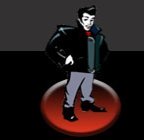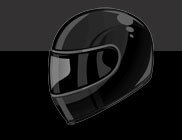 |
 |
 |
WiseGuy's Motorcycle Exhaust Guide - Better sound and more power NOW.One of the first things most of us do when we get a bike is change
the Motorcycle Exhaust
This article will not attempt to advise you as to the street legal aspects of a replacement exhaust, so Ill leave that up to you and your local law enforcement agency. ;-) Lets take a look at the why and how-to about replacement motorcycle exhausts. Why new pipes?Let's take the Yamaha R1 for example. When youre riding an earth shaking 140bhp rocket, you dont really want it to sound like an environmentally over-friendly 4bhp lawnmower. . . . . . So you decide to install an aftermarket slip-on can or full system to sweeten the sound and hopefully squeeze out a couple more ponies in the process. Lets take another scenario on the cruiser side of things. . . When I first got my Kawasaki Vulcan 800, I could barely hear the music. I felt downright out of place the first time I rode in the Trail of Tears ride. It seemed like EVERYBODY but me had loud pipes. I didnt want to just be LOUD though. I wanted my bike to sound good
too. Thats sort of difficult with an engine displacing only 800cc,
which is small by todays standards. I found satisfaction with my
Vance & Hines Cruzer
That brings me to a very important piece of motorcycle accessories
advice. I'm a bit of a cheapskate and don't like to spend "too much"
money. BUT I wish I had gone ahead and customized my motorcycle to my
liking WHEN I FIRST GOT IT. So use that as you will (or as your significant other will let you!)
The reason is that after the new wears off and you go ahead and hang on to it a couple of years. . .you'll be ready to move on to something new and you haven't had the chance to really enjoy the new pipes before it's time to sell. I'm speaking from experience. Get the new pipes NOW, if you plan to at all. Ok, enough of that! Weve taken care of the whys, now lets look at the how to of replacing a motorcycle exhaust. How to replace a motorcycle exhaustSport bike Slip-OnsBefore you take the new motorcycle exhaust out of the box, take the instructions out of the box and read them. I know, its not macho-esque to read the instructions, but its always a good idea, especially with something as expensive as a new motorcycle exhaust system. For instance, the mounting bracket will be different, it might bolt inside or outside the hanger, there will be different washers, the collector clamp might fit differently than you thought it would. It sounds tedious and it is, but its nowhere near as boring as taking everything apart and doing it again because you rushed into it. The main potential problems are not getting the clamps, etc. bolted up properly. This allows the exhaust gasses to leak (probably around the new joint between the header pipe and the new muffler). Some slip-on motorcycle exhaust systems offer a high mount option to increase ground clearance. Consult the documentation or ask your dealer if the high mount system retains the passenger foot peg or not. It may be necessary to remove it. So, now youve read the instructions. Make sure youve got the right tools, i.e. wrenches, and possibly Allen keys that fit, and get on with it. Make sure nothing is interfering with the passenger foot pegs or the swing arm. Make sure that the new pipe isnt going to blow hot gasses at your right rear turn signal or other bodywork. Once you have those checks done, double check all the fasteners and then fire it up. Some manufacturers recommend re-jetting the carburetor after replacing the stock motorcycle exhaust. This may or may not involve a dyno run, but its a good idea to have it checked. Read my Install Scorpion Exhausts guide. Cruiser or Sport bike Full SystemsFor a full motorcycle exhaust system, things get a bit more complicated, but the same basic method applies. This time however, loosely assemble the full system away from the bike This is to make sure (a) there are no parts missing, and (b) it all fits together perfectly. If there are any burrs on the joints, now is the time to deburr them with a file and some emery cloth. Dont wait until later when theyre underneath the bike and you cant get to them easily. Take anything off the bike that looks like it might get in the way. That means possibly the fairing, radiator or the oil-cooler. Make sure you know if the center-stand (if there is one) can be retained or not. Make sure you know which header pipe goes to which exhaust port. Assemble loosely at first. If everything is ok, youre ready to move on. Gently remove the old exhaust gaskets with a screwdriver or pocketknife. Clean the ports with some contact cleaner and check to make sure the studs and the threads are in good shape. Put a little high-temp grease on the new gaskets to hold them in place, and then loosely bolt the header pipes to the cylinder head. I recommend always replacing the exhaust gaskets with a new full system. I had problems with leaks on my bike until I replaced the gaskets. A long-term problem with an exhaust leak could cause engine damage. Some systems have a separate muffler. If so, its time to slide the muffler(s) over the header pipes using some more high temp grease. Snug the clamps, etc. Tighten all the bolts and clamps. Always use a torque wrench where a torque setting is specified. Re-install and refill the radiator and oil-cooler where necessary and start the engine. Rev it gently because the carburetion might well be upset due to the increased flow. Check carefully for leaks. Get the system hot, let it cool down again and then re-check all joints, clamps and bolts. Minor leaks usually seal themselves through carbon build-up, but if you can hear anything blowing, go back to step one. If everythings ok, replace the bodywork (if necessary), and make sure there are no interference fits. Now you can have a fuelling check on the dyno and marvel at the massive power gains and the nice new sound. Down the RoadAfter a few miles its always a good idea to re-check all fasteners to make sure nothing has shaken loose. Check for leaks again too. To care for your new motorcycle exhaust, keep it clean and dry. If your motorcycle exhaust is chrome, you might want to check out my article on motorcycle chrome for more tips on keeping it looking good for years. If you ever have damage and need to have your motorcycle exhaust re-chromed, learn how to choose a chrome plater. Eventually the packing in most motorcycle exhaust will wear or pack down and need to be replaced. If youd rather not be worried by this chore, investigate a Scorpion motorcycle exhaust. They have a single strand stainless packing material the NEVER needs to be replaced. If you need to find OEM replacement exhaust or aftermarket, be sure
to visit this store
A few parting exhaust notes
Now a note from the environmentally friendly side of things: Be respectful of other citizens. Dont put an extremely loud set of pipes on your bike and go roaring off through a densely populated neighborhood just to see if you can set off car alarms. As motorcyclists we need to maintain any respect that the cagers have for us. I know that may sound sissy but I dont want you messing things up for the rest of us. Ill come down off my soapbox now! :-) I really hope that this article has helped in your quest for information on motorcycle exhaust. If you have questions about installing your new pipes, contact us and well do our best to get an answer for you. Also let me know if there is any other information you wish this article had covered. Let's Ride! |
UpdatesFrom my readers |
|
|
|
||
|
Helping You Get The Most For Your Motorcycle Accessories Dollar since 2003! Copyright� 2003-2009 Motorcycle-Accessories-WiseGuy.com |
||